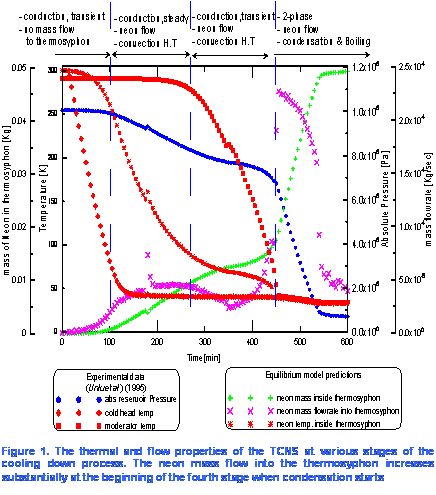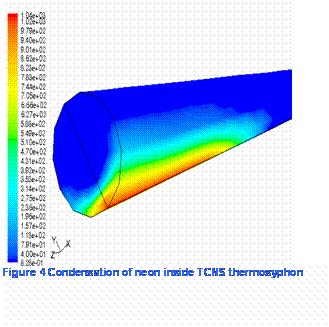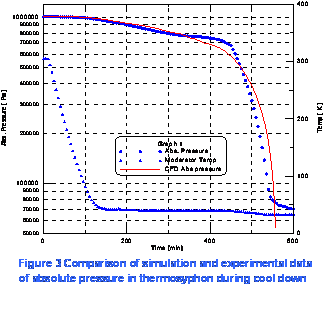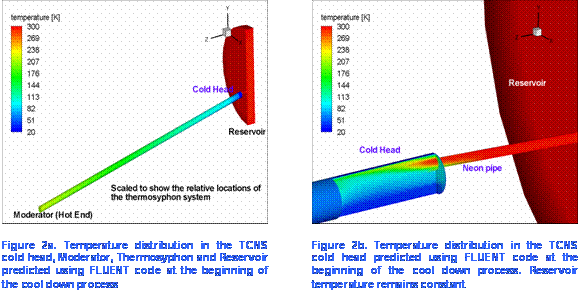
Thermal-Hydraulin Analysis of Neutron Cooling Systems
| Participants: | S. Yavuzkurt, Prof. of Mechanical and Nuclear Engineering |
| K. Ünlü, Prof. of Mechanical and Nuclear Engineering |
| H. Melaku, Ph.D. student at Mechanical and Nuclear Engineering | |
| K. Heller, PhD student at Mechanical and Nuclear Engineering |
| Services Provided: | Neutron Beam Laboratory |
| Sponsors: | Department of Energy - INIE |
| Radiation Science and Engineering Center | |
| Penn State Mechanical and Nuclear Engineering Department |
Introduction
Cold neutrons can be obtained in several ways. Only two cold neutron beam facilities were developed at the U.S. university research reactors, namely at Cornell University and the University of Texas at Austin . Both facilities used mesitylene moderator. The mesitylene moderator in the Cornell Cold Neutron Beam Facility (CNBF) [1] which is no longer available – was cooled by a helium cryorefrigerator via a copper cold finger to maintain the moderator below 30 K at full power reactor operation. The Texas Cold Neutron Source (TCNS) [2] also uses mesitylene moderator cooled via a thermosyphon containing neon. The operation of the TCNS is based on a helium cryorefrigerator, which liquefies neon gas in a 3 m-long thermosyphon. The thermosyphon cools and maintains mesitylene moderator at about 30 K in a chamber. Neutrons streaming through the mesitylene chamber are moderated and thus reduced in energy to produce a cold neutron distribution.
The basic principle used in both systems is similar. However, the thermal-hydraulic mechanism of removing the heat from the moderator chamber that is near the reactor core to the cold head that is placed outside the biological shield of the reactor is different. The CNBF system uses copper rod to transfer heat by conduction to the cold head. In the TCNS system the basic mode of heat removal involves conduction through the wall, free convection and mainly pool boiling of cold neon inside the thermosyphon. In this study the mechanisms of heat removal is analyzed and evaluated both analytically and using computational fluid dynamics and heat transfer codes mainly by using commercially available FLUENT [5] code. The advantages and disadvantages of each system will be determined. FLUENT [5] through parametric studies is being used to design a new Neutron Cooling System (NCS) for university research reactors and particularly for PSU reactor. In this paper, preliminary results of CFD simulation of TCNS are presented.
Current Study
This study focuses on detailed thermal-hydraulic analysis of both the TCNS and the CNBF cooling systems, analytically and using standard commercial thermo-fluid dynamic code such as FLUENT6.1 [5]. At the current stage of this study, the transient cooling down process of the thermosyphon is being studied. By observing the earlier measured data [1] and using equilibrium model to derive neon temperature and mass flow rate, it has been concluded that the basic mechanism of the cooling down process consists of four dominant stages as shown in Figure 1: 1. Transient startup, 2. Cooling down of neon gas 3.Cooling down of the moderator, 4. Condensation and pool boiling. The neon temperature and mass flow rate were derived using ideal gas model from the measured pressure data and assuming thermodynamic equilibrium conditions.
The various models of heat transfer process are being developed in order to incorporate them into the FLUENT solver. The computational domain is prepared using GAMBIT software which is the default grid generation tool for FLUENT. Figure 2a and Figure 2b show the result of the temperature distribution at the inlet to the thermosyphon during the early stages of the cooling down process. Sufficiently fine computational grid sizes ranging from 60,000 to 120,000 cells depending on the flow regime were required to capture the high temperature gradient and for ease of convergence of the solution. However, this comes at the expense of calculation time for the transient system with a relatively large aspect ratio of the domain. In this case the computational domain is of 3.35 m long and of 19 mm diameter thermosyphon tube connected to a 6.5 l neon reservoir. Efforts are being made to reduce the skewness factor of the grid as low as possible by using hexagonal mesh wherever possible in the flow domain.
The computational result together with the experimental data obtained previously is expected to lead to a better design for the Penn State cold neutron source.
Set Up and Preparation of the CFD Simulation
The default preprocessor software for Fluent which is GAMBIT was used to prepare the computational domain of the TCNS and generate the finite volume cells. The total number of cells of the flow domain was 6700 cells. The mesh sizes were varied according to the anticipated flow structure such that more cells were used wherever there is large velocity or temperature gradients. To take advantage of the flow symmetry and save computation time the analysis was made by splitting the above flow domain in half along the length of the tube. Symmetry boundary condition will then be applied along the cutting plane . In order to perform an accurate CFD simulation, all the boundary conditions at the various surfaces of the flow domain must be known. Due to the nature of the operational temperature range of the system, the cold head temperature can be affected by even a small exposed (un-insulated) thermocouple wire. The operation manual recommends that these wires should be thermally shielded. The amount of heat removed by the cryorefrigeration system at the cold head during the cooling down stages of the TCNS is not known. However, the temperature at the cold head during cooling down stages was measured previously[1] and this was taken as a temperature boundary condition for the CFD simulation. The temperature data was curve fitted and a "C" code was written to interface it within FLUENT as a UDF after compiling.
The geometry and material properties of the tube that connects the neon tank and the thermosyphon affect the heat transfer. In this revised simulation the length of the tube was increased to 5 m. The internal diameter of the tube is 3 mm. From the initial simulations it appears that the neon tube is a major heat load to the cooling system in the initial cooling period. The boundary condition at the surface of the neon tube was set to be room temperature of 300 K.
The reservoir was located outside the biological shield and hence the surface temperature should be assumed to be room temperature of 300 K. Since it is located inside the biological shield, the boundary condition for the thermosyphon wall was set to be an insulated wall.
The working fluid for the TCNS thermosyphon was neon gas. The initial condition of the gas is a room temperature of 300 K and pressurized to 10 atm. In this simulation neon was considered as an ideal gas and hence the ideal-gas model was selected for the variation of density in the simulation. In order to account for the continuous drop of absolute pressure in the system during cool down, the floating pressure option was activated. Previous simulations have shown that this was a major source of instability in the convergence of the simulation.
Two-phase flow analysis
The condensation and boiling of the neon gas inside the thermosyphon should be modeled using the general two phase modules of FLUENT. This can be accomplished by using a two phase flow UDF to simulate the condensation and boiling inside the thermosyphon. Condensation on the inside wall of the cold head starts when the neon gas inside the thermosyphon reaches at or below the saturation temperature at the prevailing saturation pressure. Since the pressure inside the thermosyphon continuously changes the saturation temperature also changes continuously. The UDF that should be incorporated should account for the continuously changing saturation condition. The saturation temperature vs. pressure of neon was incorporated into FLUENT by using a curve fit.
Preliminary results
The simulation result shown in figure 3 is the latest result of prediction of the absolute pressure in the neon reservoir. This simulation was carried out by taking the variation of physical and thermal properties of both aluminum and neon with temperature. The operating temperature and pressure range of the TCNS was about 28 K and 40 kPa respectively. At such a low temperature the thermal properties were found to be exteremely sensitive to temperature. These effects were included during the simulation. From the result it was possible to see that the absolute pressure in the neon reservoir was accurate up to the beginning of condensation. At this point the simulation beyond the condensation point is being carried out. The simulation result of the moderator temperature, that is not shown here was not in a good agreement with the data which suggests that there needs to be improvement to the condensation modeling. However initial results shown in Figure 4 show how the condensed neon liquid accumulates at the moderator end of the thermosyphon.

Conclusions
Neutronic performance of both the CNBF and TCNS systems are known and published previously. However, thermal and thermal-hydraulic behavior of both systems have never been analyzed in detail. Currently both the TCNS and the CNBF cooling systems are being analyzed in order to design and build a third generation mesitylene based cold neutron source at Penn State . The Penn State cold neutron source will be designed with a superior cooling system and an optimized cold neutron beam output. A parallel research to this proposed study is ongoing for the size and shape optimization of Penn State cold moderator chamber. An equilibrium analysis of the experimental data gave four distinctive thermal regimes when plotted as a function of time. These are being used to make the thermal modeling easier. Results from the initial analysis of the TCNS cooling system using FLUENT are encouraging. Following the characterization of the thermal behavior of both systems and parametric studies, a model will be developed for the best performance of university reactor based cold neutron source.
References
• K. Ünlü, C. Rios-Martinez, B. W. Wehring, "The University of Texas Cold Neutron Source," Nucl. Instr. and Meth.," A 353, (1994),397
• D. D. Clark, C. G, Quellet, and J. S. Berg, "On the Design of Cold Neutron Source," Nucl. Sci. Eng. 110 (1992) 445
• C. Rios-Martinez, K. Ünlü, Thomas L. Bauer and B. W. Wehring, “Performance of neon thermosiphon in the Texas cold neutron source,” Trans. Am. Nucl. Soc ., 71 692 (1994)
• C. Rios-Martinez, K. Ünlü, and B. W. Wehring, “Thermal-Hydraulic and Neutronic Performance of the Texas Cold Neutron Source,” Sociedad Nuclear Mexicana, IV. Congreso Anual Memorias, Vol 1 , 148 (1993)
• FLUENT-Computer Code, FLUENT Inc. Centerra Park Lebanon , New Hampshire 03766




